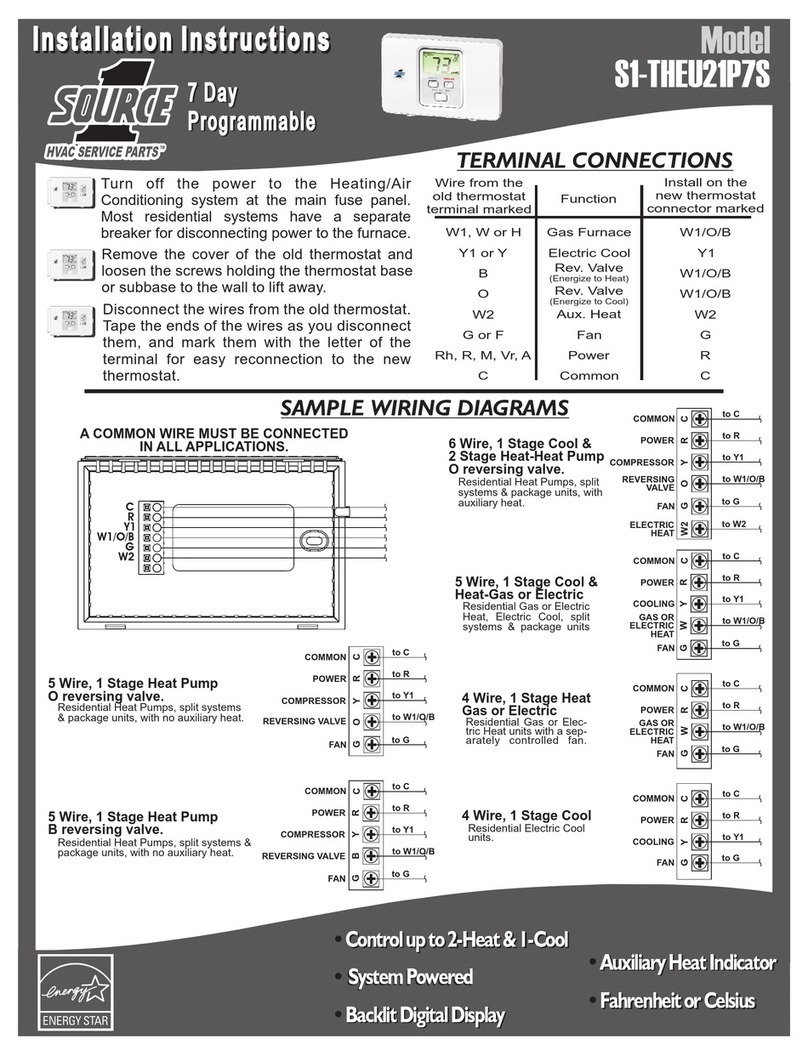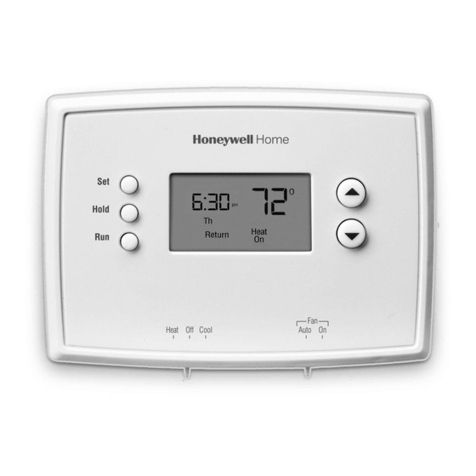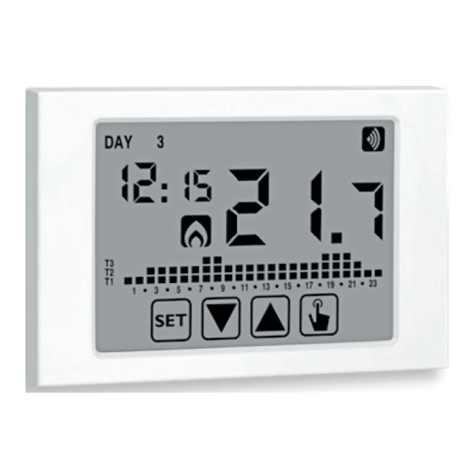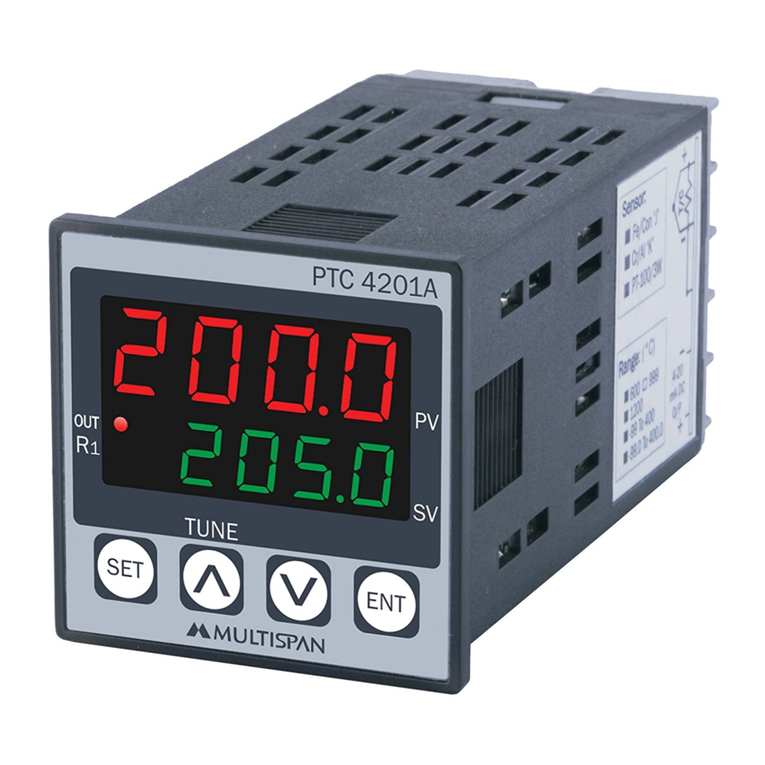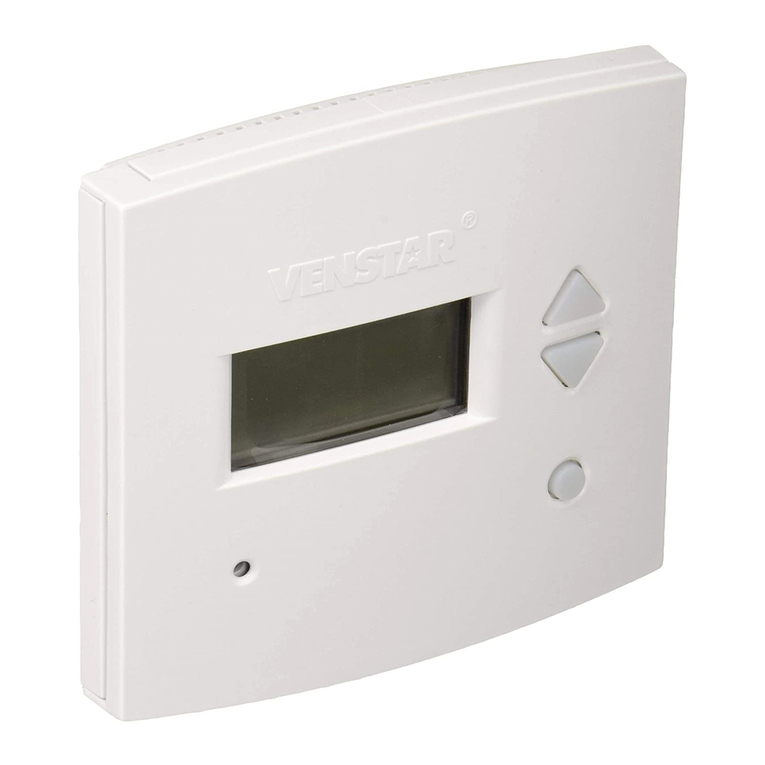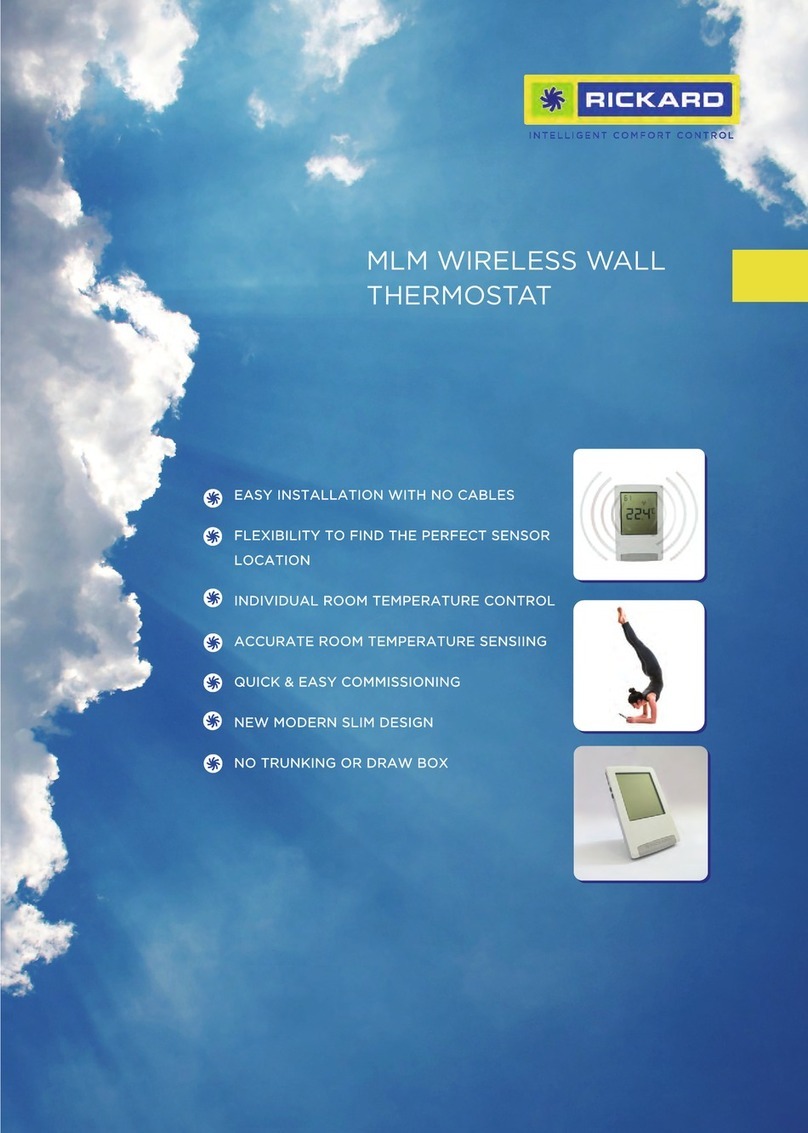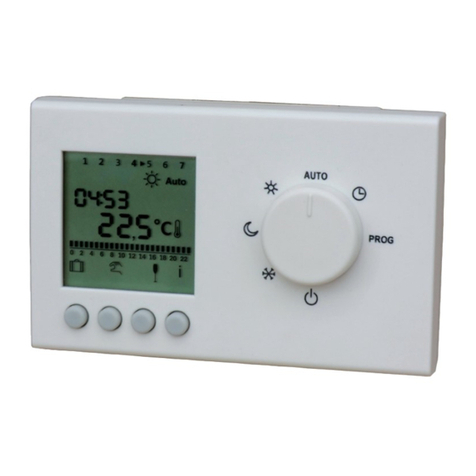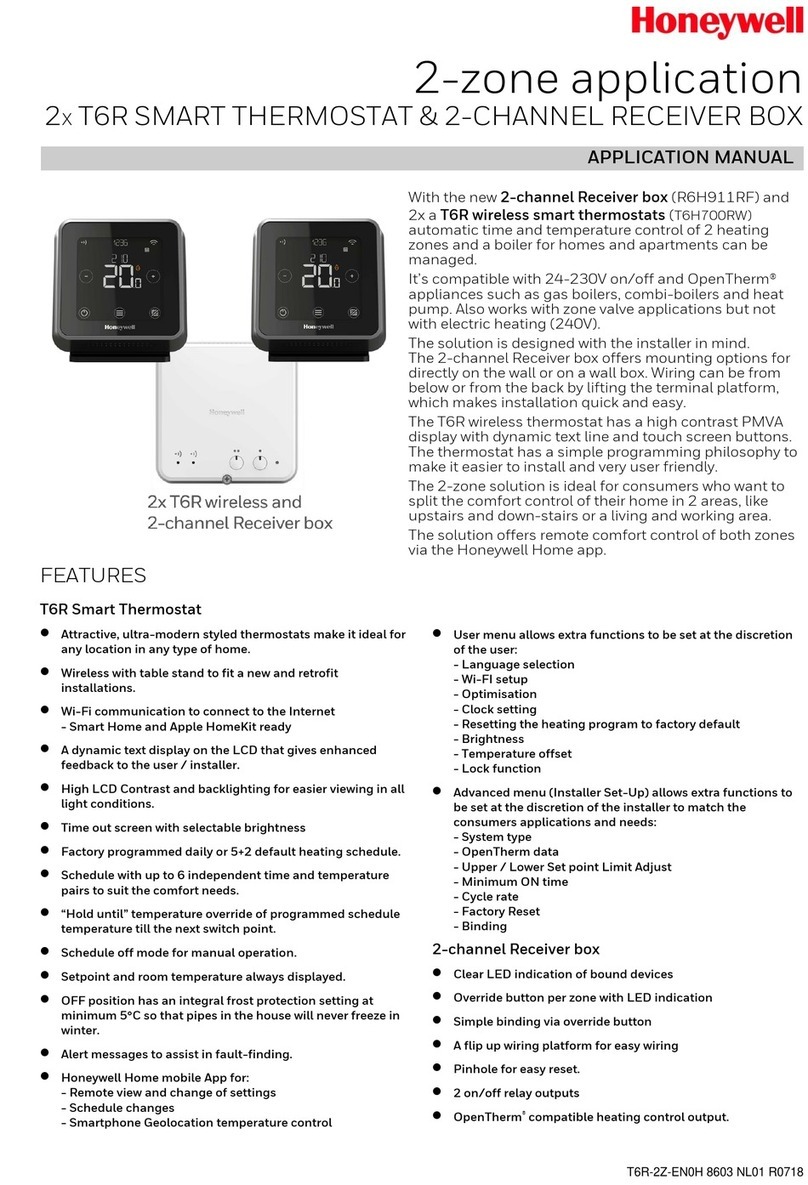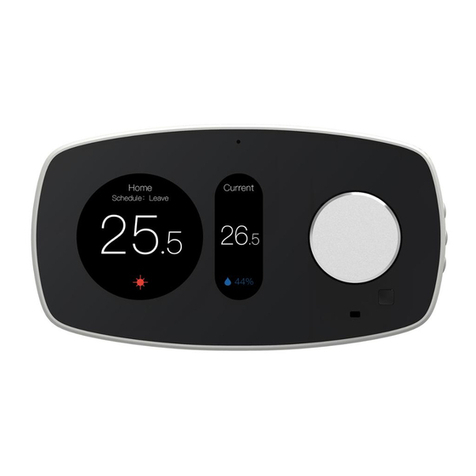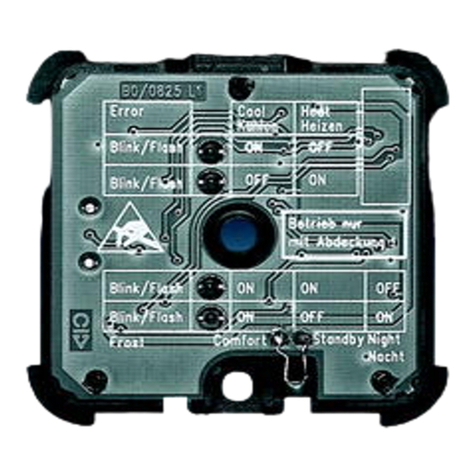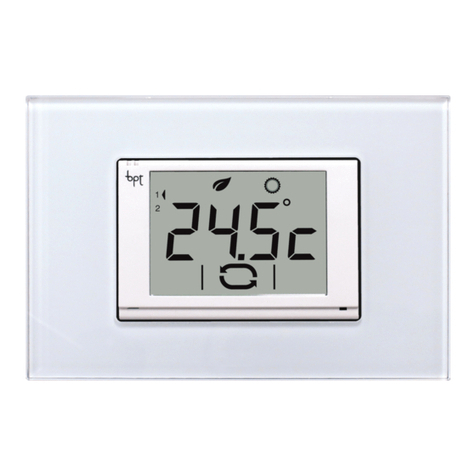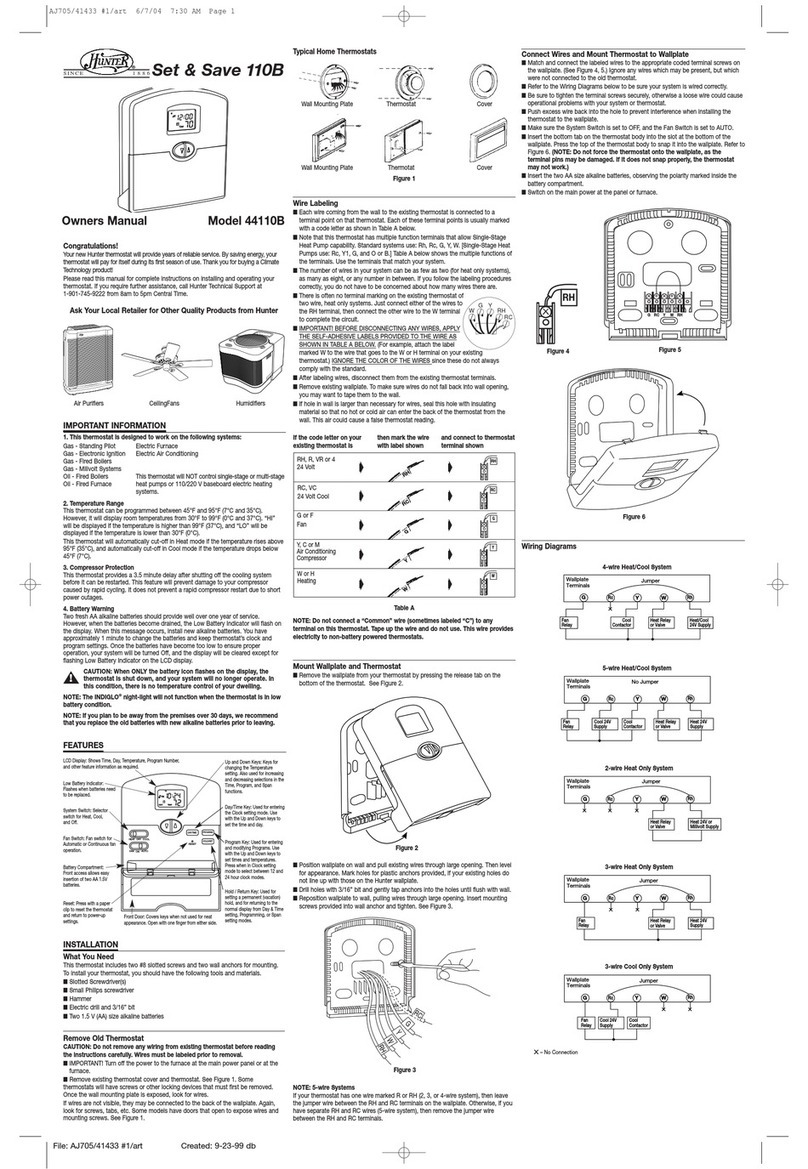Source 1 S1-TBSU22HN Operating instructions

Owner’s Manual
Owner’s Manual
Digital Thermostat
LX Series
Digital Thermostat
LX Series
COMMERCIAL
S1-TBSU22HN
S1-TBSU32P7
S1-TBSU32HP7
Model
BACKLIT DISPLAY
and
and
Installation Instructions
Installation Instructions
OVERRIDE


Page i
NOTE: Due to variations in environmental conditions, it is not
always possible to achieve the desired humidification or
dehumidification setpoint.
This device complies with Part 15 of the FCC Rules. Operation is
subject to the following two conditions: (1) this device may not cause
harmful interference, and (2) this device must accept any interference
received, including interference that may cause undesired operation.
Follow the Installation Instructions before proceeding.
Set the thermostat mode to “OFF” prior to changing
settings in setup or restoring Factory Defaults.
CAUTION
C
c
F
FOR HOME OR OFFICE USE
Tested to Comply
with FCC Standards
Thermostat LX
4Z95


Glossary of Terms
Page ii
Auto-Changeover: A mode in which the thermostat will turn on the
heating or cooling based on room temperature demand.
Cool Setpoint: The warmest temperature that the space should rise
to before cooling is turned on (without regard to deadband).
Deadband: The number of degrees the thermostat will wait, once a
setpoint has been reached, before energizing heating or cooling.
Dehumidify: To reduce the amount of moisture in the air.
Differential: The forced temperature difference between the heat set-
point and the cool setpoint.
Heat Setpoint: The coolest temperature that the space should drop
to before heating is turned on (without regard to deadband).
Humidify: To increase the amount of moisture in the air.
Icon: The word or symbol that appears on the thermostat display.
Mode: The current operating condition of the thermostat (i.e. Off,
Heat, Cool, Auto, Program On).
Non-Programmable Thermostat: A thermostat that does not have
the capability of running Time Period Programming.
Programmable Thermostat: A thermostat that has the capability of
running Time Period Programming.
Reheat: Running the cooling and 2nd stage strip heaters at the same
time in order to dehumidify the air without cooling down the room
temperature.
Temperature Swing: Same as Deadband.
Time Period Programming: A program that allows the thermostat to
automatically adjust the heat setpoint and/or the cool setpoint based
on the time of the day.


Table of Contents
Page iii
5
1
17
18
23
24
24
25
26
27
28
31
15
Quick Start
Get to Know Your Thermostat
USER SETUP
Programming Fan Operation
Thermostat Display Options
Humidification & Dehumidification
Timers and Deadbands
Remote Sensor Operation
Auxiliary Output
Factory Defaults
Dry Contact Operation
INSTALLER SETUP
16
Scrolling Display Options
System Runtimes
Time Period Programming
Program Mode Operation
TECHNICIAN SETUP
36
Advanced Output Testing
Programming Holiday Mode
Equipment Testing
Comfort Recovery Operation
21
Backlight Operation
32
33
Troubleshooting
Sensor Calibration 32
32
INDEX
16
17
Emergency Heat
20
34
Advanced Setup Table
7
INSTALLATION INSTRUCTIONS
Sample Wiring Diagrams 11
Test Operation 14


OVERRIDE
OVERRIDE
HOLIDAY
MODE
Page 1
Emergency
Heat Holiday Accessory
Humidity*
Outdoor Temp.
Mode
Cooler
Button Override
Button Warmer
Button
Heat or Cool
Demand Indicator
Red = Heat, Green = Cool
Backlit LCD Display
Display
Options
Setup
Program
Off | Run | Set
Set
Clock
Get to Know Your Thermostat
Front Panel
Scrolling Display
(This feature not available on all models)
SERVICE
on some models
(
(
RST FLTR
on some models
(
(
FAN
on some models
(
(

H
Lo
Program ONOFF
Outdoor
Fan On
COOL SET
A HEAT ETUX S
Setup Step
2nd3rd
Stage
Am
Pm
18:88
188
188
88
188
Page 2
Mode Indicators
Selects the operational mode of the equipment.
HEAT - Indicates the heating mode.
COOL - Indicates the air conditioning mode.
HEAT & COOL - Indicates the system will automatically change-
over between heat and cool modes as the temperature varies.
OFF - Indicates heating and cooling is turned off.
Clock with Day of the Week
Indicates the current time and day. This clock is also used to
program the time period schedules.
Room Temperature Display
Indicates the current room temperature and displays the outdoor
temperature when selected.
Outdoor icon
Indicates the temperature displayed is from the optional outdoor
sensor.
The scrolling display will be used to help you easily navigate the setup
screens in the thermostat.
Get to Know Your Thermostat
6
Program icon
Indicates that Time Period Programming is enabled to be set.
6
Unoccupied123
Override
Display Features

H
Lo
Program ONOFF
Outdoor
Fan On
COOL SET
A HEAT ETUX S
Setup Step
2nd3rd
Stage
Am
Pm
18:88
188
188
88
188
Page 3
Display Features
Desired Set Temperature
Indicates desired room temperature(s). Also displays the highest
and lowest temperatures for the day.
Occupied & Unoccupied icons
Indicates the program number: Occupied 1,2,3 or Unoccupied.
Override icon
Indicates the program is currently being overridden for up to 4
hours.
Setup Step icon
Indicates the step number when the thermostat is in the
setup mode.
icon
Indicates the keypad has been locked.
Get to Know Your Thermostat
12
12
11
10
Unoccupied123
Override
9
2nd and 3rd Stage icons
Indicates what stage of cooling or heating is currently
energized.
11
10

H
Lo
Program ONOFF
Outdoor
Fan On
COOL SET
AUX
HEAT SET
Day Night
Morning
Evening
Setup Step
2nd3rd
Stage
Am
Pm
18:88
188
188
88
188
AuxHeat icon
Indicates 2nd stage electric strip heat is being used when the
thermostat is programmed for Heat Pump operation. Only the
Aux icon will appear during Cool to Dehumidify to indicate Reheat
operation.
Lo icon
Indicates the lowest recorded outdoor temperature for the day.
Hi icon
Indicates the highest recorded outdoor temperature for the day.
Fan On icon
Indicates constant, continuous fan operation.
When Fan On is not lit - indicates the fan will only operate when
necessary to heat or to cool.
Page 4
Get to Know Your Thermostat
15
Unoccupied123
Override
13
14
15
16
13
14
15
16
Display Features

Page 5
Press the WARMER or COOLER buttons to modify the selection.
Setting the Clock
Quick Start
Set Clock
Press the SET CLOCK button. Adjust the clock using the WARMER or COOLER
Press the MODE button to advance and confirm through the setup steps.
During Setup and Programming:
buttons. Press MODE to advance to the day setting. Adjust the day using the
WARMER or COOLER buttons. Press the SET CLOCK button to confirm settings.
and Day
MODE
TIP: To adjust the time by hours press and hold the OUTDOOR button while pressing
the WARMER or COOLER buttons.
Selecting the Heat or Cool Mode
Select mode by pressing the MODE button.
Heating Only - The HEAT setting indicates the temperature the room has to reach
before the furnace will turn on to heat the room.
Cooling Only - The COOL setting indicates the temperature the room has to reach
before the air conditioner will turn on to cool the room.
Heating or Cooling (Auto-Changeover) - AUTO will automatically select heat or cool
based on room temperature demand.
OFF - OFF indicates both heating and air conditioning systems are turned off.
MODE
Selecting Your Desired Temperature
AUTO-CHANGEOVER MODE - Pressing the WARMER or COOLER buttons in Auto or
Program mode will adjust both the heat and cool setpoints simultaneously. To adjust
heat and cool setpoints individually, choose HEAT mode to adjust the heat setpoint and
COOL mode to adjust the cool setpoint, then return to AUTO mode.
HEAT OR COOL MODE - Pressing the WARMER or COOLER buttons in Heat or
Cool mode will adjust only the heat or cool setpoints individually displayed.
(This feature not
available on all models)

Page 6
Quick Start
Using the Override Button
Unoccupied Operation - During programmed, unoccupied periods, pressing the
OVERRIDE button will force the thermostat into Occupied 1 settings for 30 minutes.
Each press of the OVERRIDE button will add another 30 minutes of time for up to 4
hours. If the maximum time has been set, the next press of the OVERRIDE button
will reset the timer and return the thermostat to the correct time period program for the
day.
Viewing the Outdoor and Remote Temperature Sensors
OUTDOOR TEMP - Press the OUTDOOR
button to view the current outdoor temperature.
The high and low temperatures for the day will
also be displayed. The high and low temperatures reset at 12:00 am.
REMOTE TEMP - Pressing the OUTDOOR button once will display the current
outdoor temperature. Press the OUTDOOR button again to display POOL or SPA
temperature sensors. Each press of the OUTDOOR button will display a different
installed sensor. Keep pressing the OUTDOOR button to return to normal operation.
Note: If no outdoor sensor is connected, 2 dashes [- -] will appear with
the first button press.
Viewing the Indoor Humidity Sensor*
Press the HUMIDITY button t
the thermostat. The room relative humidity is displayed in the top left corner. The
humidification setpoint appears in the larger center display and can be adjusted using
the WARMER or COOLER buttons. Press the HUMIDITY button again to view and
adjust the dehumidification setpoints.
return to normal operation.
o display the current humidity measured at
Press the HUMIDITY button again to confirm
settings and
Note: Due to variations in environmental conditions, it is not always
possible to achieve the desired humidification or dehumidification
setpoint.
IMPORTANT: Allow at least 2 minutes after the thermostat
is powered on for the humidity to read correctly.
(This feature not available on all models)
OVERRIDE
NOTE: Override may only be
used when the thermostat is
set to PROGRAM ON.
Occupied Operation - During programmed, occupied periods, pressing the OVER-
RIDE button will force the thermostat into an unoccupied period for the rest of the day.
During this forced unoccupied period the OVERRIDE button will operate as described
above.

Page 7
Assemble tools: Flat blade screwdriver, wire cutters and wire
strippers.
Carefully unpack the thermostat. Save the screws, any brack-
ets, and instructions.
Make sure your Heater/Air Conditioner is working properly
before beginning installation of the thermostat.
Turn off the power to the Heating/Air Conditioning system at
the main fuse panel. Most residential systems have a separate
breaker for disconnecting power to the furnace.
To install the thermostat properly, please follow these step by
step instructions. If you are unsure about any of these steps,
call a qualified technician for assistance.
I
Am
Outdoor
COOLSET
HEAT ETS
2:00
78
74
68
85
MO
YOUR NAME
COOLER MODE WARMER
I
Am
Outdoor
COOLSET
HEAT ETS
2:00
78
74
68
85
MO
YOUR NAME
COOLER MODE WARMER
I
Am
Outdoor
COOLSET
HEAT ETS
2:00
78
74
68
85
MO
YOUR NAME
COOLER MODE WARMER
I
Am
Outdoor
COOLSET
HEAT ETS
2:00
78
74
68
85
MO
YOUR NAME
COOLER MODE WARMER
Remove the cover of the old thermostat. If it does not come off
easily, check for screws.
Loosen the screws holding the thermostat base or subbase to the
wall and lift away.
Keep the old thermostat for reference purposes, until your new
thermostat is functioning properly.
Disconnect the wires from the old thermostat. Tape the ends
of the wires as you disconnect them, and mark them with the
letter of the terminal for easy reconnection to the new thermo-
stat.
I
Am
Outdoor
COOLSET
HEAT ETS
2:00
78
74
68
85
MO
YOUR NAME
COOLER MODE WARMER
I
Am
Outdoor
COOLSET
HEAT ETS
2:00
78
74
68
85
MO
YOUR NAME
COOLER MODE WARMER
I
Am
Outdoor
COOLSET
HEAT ETS
2:00
78
74
68
85
MO
YOUR NAME
COOLER MODE WARMER
I
Am
Outdoor
COOLSET
HEAT ETS
2:00
78
74
68
85
MO
YOUR NAME
COOLER MODE WARMER
Remove & Replace the Old Thermostat
Installation Instructions

Page 8
Wire Connections
If the terminal designations on your old thermostat
do not match those on the new thermostat, refer
to the chart below or the wiring diagrams
that follow.
* O/B is used if your system is a Heat Pump.
I
Am
Outdoor
COOLSET
HEAT ETS
2:00
78
74
68
85
MO
YOUR NAME
Wire from the
old thermostat
terminal marked Function
Install on the
new thermostat
connector marked
G or F Fan G
Y1, Y or C Cooling Y1
W1, W or H Heating W1/O/B
PowerRh, R, M, Vr, A R
C
O/B
C
Common
Rev. Valve
W2 2nd Stage Heat
Y2
CKGND Dry Contact Switch
Y2
W3W3
H, HUM HUM
Ck1 Dry Contact Switch DRY CONTACT
DRY CONTACT
W1/O/B*
W2
D, DEHUM DEHUM
2nd Stage Cooling
3rd Stage Heat
Humidity
Dehumidity
Wire Connections
Installation Instructions

Page 9
24 VAC return
Fan relay
1st stage heat circuit
1st stage compressor relay
2nd stage heat circuit
The LX Thermostat Backplate
G
Y1
Y2
W3
R
W1/O/B
W2
HUM
DEHUM
C
AUX
REMOTE
SENSOR
DRY
CONTACT
OUTDOOR
SENSOR
G
Y1
Y2
W3
R
W1/O/B
W2
HUM
DEHUM
C
AUX
REMOTE
SENSOR
DRY
CONTACT
OUTDOOR
SENSOR
2nd stage compressor relay
3rd stage heat circuit
Humidifier control circuit
Dehumidifier control circuit
24 VAC common
Aux output
Outdoor sensor
connections
Remote sensor
connections
Dry contact
connections
IMPORTANT: This thermostat requires both
R (24 VAC Return) and C (24 VAC Common) be
connected to the backplate terminals.
Installation Instructions
Front Housing
Backplate
To remove the thermostat
backplate: Using the Finger
Pull Areas, pull the front
housing away from the
backplate.
Finger Pull Areas

Page 10
Explanation of Thermostat Jumpers
Jumpers are located on the back of the thermostat
GAS/ELEC
HEATPUMP
GAS
ELEC
RV=O
RV=B
J3J2J1
(FAN)
C
AUX
OUTDOOR
DRY
CONTACT
SENSOR
REMOTE
SENSOR
R
G
W1/O/B
W3
HUM
W2
Y1
Y2
DEHUM
GAS/ELEC
HEATPUMP
GAS
ELEC
RV=O
RV=B
J3J2J1
This jumper configures the thermostat to control a conventional
gas/electric system or a heat pump. If your system is anything
other than a heat pump, leave this jumper set for GAS/ELEC.*
GAS/ELEC
HEATPUMP
GAS/ELEC
HEATPUMP
OR
J1
When J1 is configured to control a heat pump, this jumper (J2)
must be set to control the appropriate reversing valve. If RV=O
is chosen, the W1/O/B terminal will energize in cooling. If RV=B
is chosen, the W1/O/B terminal will energize in heating.
When J1 is set for GAS/ELEC:
This jumper (J3) controls how the thermostat will control the
Fan (G) terminal in heating mode. When GAS is chosen, the
thermostat will not energize the Fan (G) terminal in heating.
When ELEC is chosen the thermostat will energize the fan in
heating.
OR
J2
OR
J3
RV=O
RV=B
RV=O
RV=B
GAS
ELEC
(FAN)
GAS
ELEC
(FAN)
*For some commercial heat pumps, this jumper will need to
be set for GAS/ELEC. Consult the commercial heat pump literature.
Installation Instructions

Page 11
Residential & Commercial 1 Stage Heating
with no Fan.
3 Wire, Heat Only
24VAC Power
24VAC Common
1st Stage Heat
Gas/Elec
O (not used)
Gas
Residential & Commercial 1 Stage Cooling.
4 Wire, Cool Only
R
C
Y1
G
J1 =
J2 =
J3 =
Installation Instructions
Conventional Heating and Cooling Systems
Residential & Commercial 1 Stage Cooling,
with 1 stage Gas Heat.
5 Wire, 1 Stage Cooling, 1 Stage Heat
24VAC Power
24VAC Common
1st Stage Heat
1st Stage Cool
Fan
Gas/Elec
O (not used)
Gas
Residential & Commercial 1 Stage Cooling,
with 1 stage Electric Heat.
5 Wire, 1 Stage Cooling, 1 Stage Heat
24VAC Power
24VAC Common
1st Stage Heat
1st Stage Cool
Fan
Gas/Elec
O (not used)
Electric
Residential & Commercial 2 Stage Cooling,
with 3 stage Gas Heat.
8 Wire, 2 Stage Cooling, 3 Stage Heat
24VAC Power
24VAC Common
1st Stage Heat
2nd Stage Heat
3rd Stage Heat
1st Stage Cool
2nd Stage Cool
Fan
Gas/Elec
O (not used)
Gas
Sample Wiring Diagrams
R
C
W1/O/B
Y1
G
J1 =
J2 =
J3 =
R
C
W1/O/B
Y1
G
J1 =
J2 =
J3 =
R
C
W1/O/B
W2
W3
Y1
Y2
G
J1 =
J2 =
J3 =
R
C
W1/O/B
J1 =
J2 =
J3 =
24VAC Power
24VAC Common
1st Stage Cool
Fan
Gas/Elec
O (not used)
Gas

Page 12
Installation Instructions
Residential & Commercial Heat Pump with
‘O’ Reversing Valve
5 Wire, 1 Stage Cooling, 1 Stage Heat
R 24VAC Power
C 24VAC Common
W1/O/B Reversing Valve
Y1 1st Stage Compressor
(Cool or Heat)
G Fan
J1 = Heat Pump
J2 = O
J3 = Gas
Residential & Commercial Heat Pump with
‘O’ Reversing Valve.
8 Wire, 2 Stage Cooling, 4 Stage Heat
R 24VAC Power
C 24VAC Common
W1/O/B Reversing Valve
W2 3rd Stage Heat
W3 4th Stage Heat
Y1 1st Stage Compressor
(Cool or Heat)
Y2 2nd Stage Compressor
(Cool or Heat)
G Fan
J1 = Heat Pump
J2 = O
J3 = Electric
Setup Step 24 is set to 2
(Number of Compressor Stages)
Residential & Commercial Heat Pump with
‘O’ Reversing Valve
6 Wire, 1 Stage Cooling, 2 Stage Heat
R 24VAC Power
C 24VAC Common
W1/O/B Reversing Valve
Y1 1st Stage Compressor
(Cool or Heat)
W2 Aux Heat
G Fan
J1 = Heat Pump
J2 = O
J3 = Electric
Residential & Commercial Heat Pump with
‘O’ Reversing Valve.
7 Wire, 2 Stage Cooling, 3 Stage Heat
R 24VAC Power
C 24VAC Common
W1/O/B Reversing Valve
W2 3rd Stage Heat
Y1 1st Stage Compressor
(Cool or Heat)
Y2 2nd Stage Compressor
(Cool or Heat)
G Fan
J1 = Heat Pump
J2 = O
J3 = Electric
Setup Step 24 is set to 2
(Number of Compressor Stages)
Sample Wiring Diagrams
Heat Pump Systems
This manual suits for next models
2
Table of contents
Other Source 1 Thermostat manuals

Source 1
Source 1 S1-TBSU306-S Original instructions
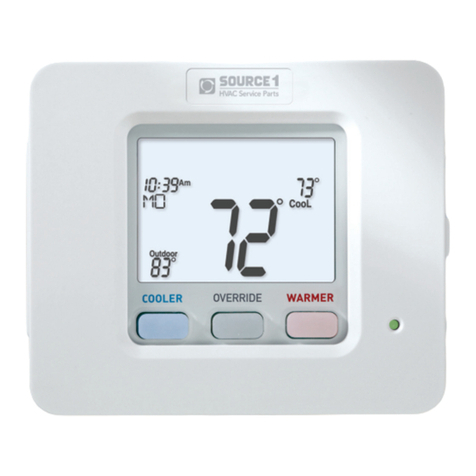
Source 1
Source 1 S1-TBSU305-S Original instructions
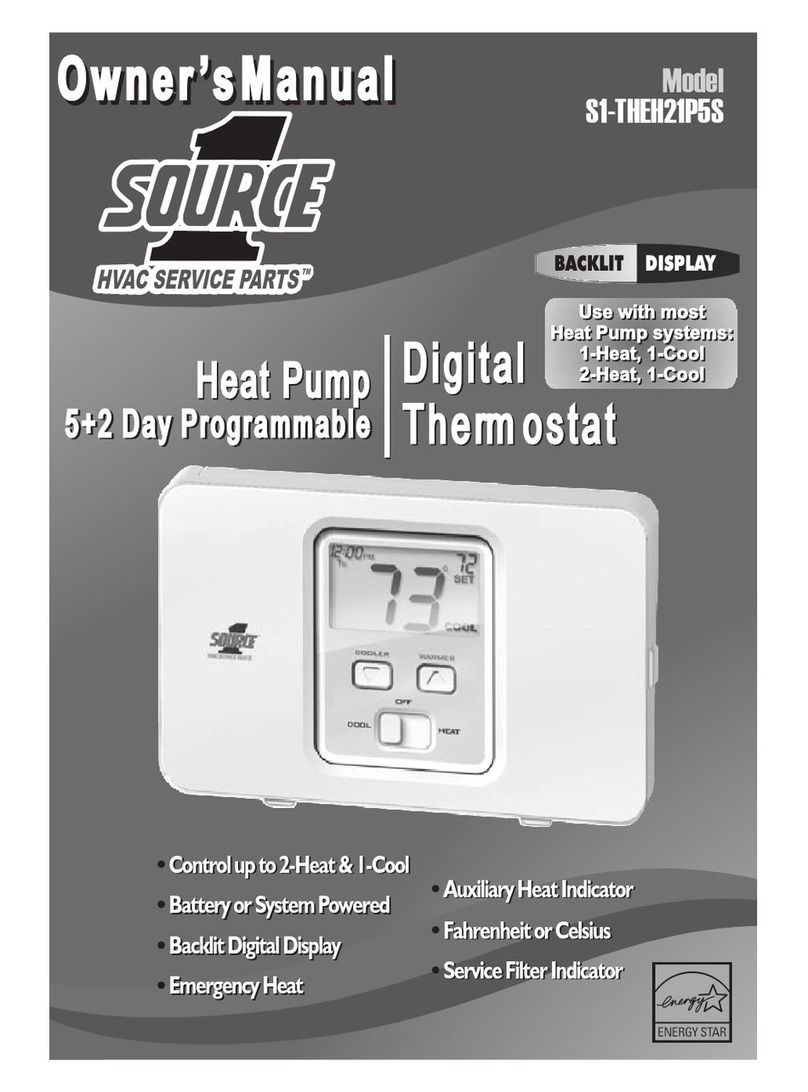
Source 1
Source 1 S1-THEH21P5S User manual
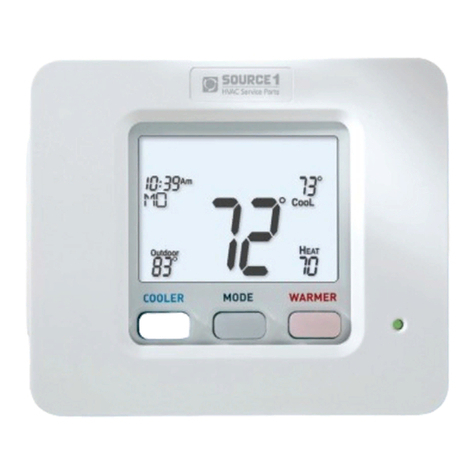
Source 1
Source 1 S1-THSU301-S Original instructions

Source 1
Source 1 S1-THEH21NS User manual

Source 1
Source 1 S1-THEC11P5S User manual
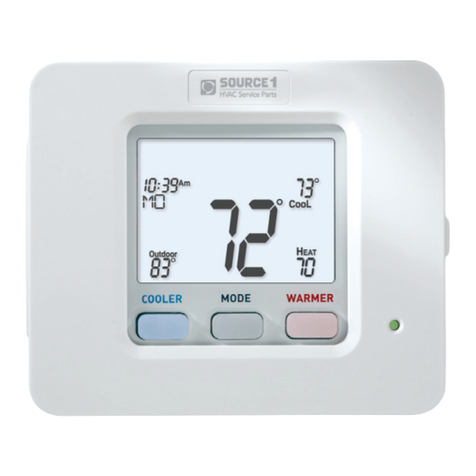
Source 1
Source 1 S1-THSU302-S Original instructions

Source 1
Source 1 S1-THEM22P7S User manual
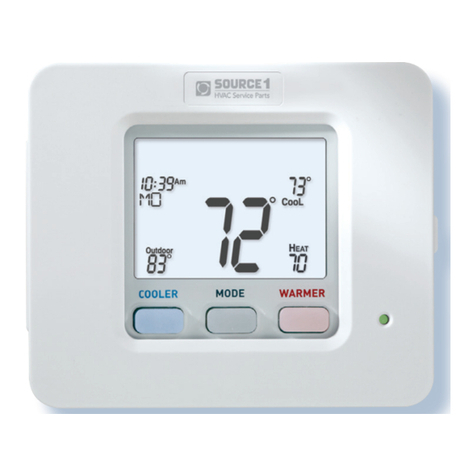
Source 1
Source 1 S1-THSU303-S Original instructions
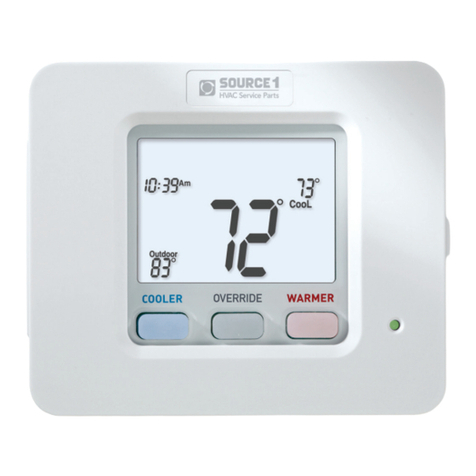
Source 1
Source 1 S1-TBSU304-S Original instructions
